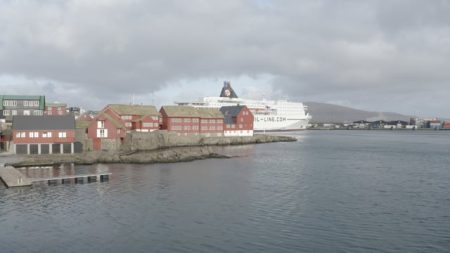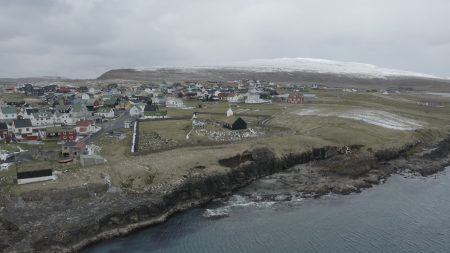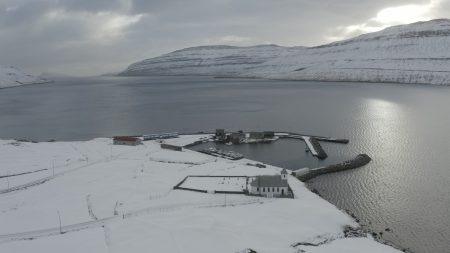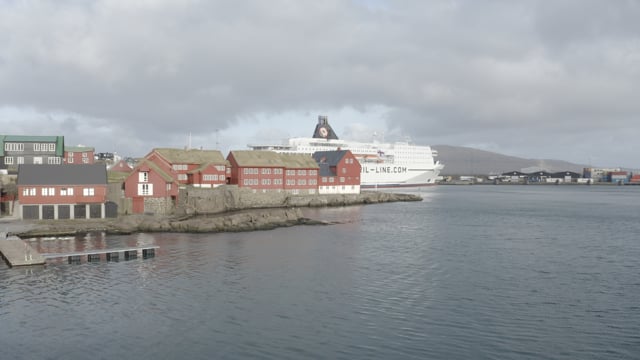The new Norröna is a modern cruiseferry. It was built in Lübeck, Germany, and had its maiden voyage in April 2003.
Norröna has a total LOA (length overall) of 165 metres (541 ft), and a width of 30 metres (98 ft); 34.23 m (112.3 ft) with lifeboats.
She has a total of 318 passenger cabins and 72 crew cabins, which accommodates the space of approximately 1,482 passengers and 118 crew members.
She has a total of 1,830 metres (6,000 ft) of trailer lane, with space for 800 cars or 130 cargo trailers.
Her cruising speed is approximately 21 knots (39 km/h; 24 mph).
Norröna is the only way to take personal cars to the Faroe Islands and Iceland from Denmark or from the Faroe Islands and Iceland to Denmark.
Tórshavn (‘Thor’s harbour‘; Danish: Thorshavn), locally referred to as Havn, is the capital and largest city of the Faroe Islands.
It is located in the southern part on the east coast of Streymoy. To the northwest of the city lies the 347-meter-high (1,138 ft) mountain Húsareyn,
and to the southwest, the 350-meter-high (1,150 ft) Kirkjubøreyn. They are separated by the Sandá River.
The city itself has a population of 14,038 (2024), and the greater urban area has a population of 23,160, including the suburbs of Hoyvík and Argir.
The Norse (Scandinavians) established their parliament on the Tinganes peninsula in AD 850.
Tórshavn thus became the capital of the Faroe Islands and has remained so ever since. Early on,
Tórshavn became the centre of the islands’ trade monopoly, thereby being the only legal place for the islanders to sell and buy goods.
In 1856, the trade monopoly was abolished and the islands were left open to free trade.
Sources do not mention a built-up area in Tórshavn until after the Protestant reformation in 1539. In c. 1580 a small fort, Skansin, was built
by the Faroese naval hero and trader Magnus Heinason at the north end of the harbour. Later, small fortifications were built at Tinganes.
In 1584, Tórshavn had 101 inhabitants. The population was divided into three equally large groups made up of farmers, their families and
servants, trade and government officials and people who owned no land and therefore not much else; this included the landless
proletariat from the villages that during this period came to Tórshavn in search of work.
They were set to guard duty on Skansin without pay, and for clothing and food they depended on the bounty of the farmers.
In 1655, king Frederick III of Denmark granted the Faroe Islands to his favourite statesman Kristoffer Gabel; the rule of the von Gabel Family
(lasting between 1655 and 1709), is known as Gablatíðin. It is the darkest chapter in the history of Tórshavn.
Gabel’s administration suppressed the islanders in various ways.
The trade monopoly was in the family’s hands and it was not designed for the needs of the Faroese people.
People across the country brought products into town and had to be satisfied with whatever price they were given.
At the same time, imported goods were limited and expensive. There came considerable complaints from
the islands’ inhabitants of unjust treatment by the civil administration in Tórshavn.
These not only included the persons in charge of the monopoly trade, but also the bailiff and others.
It was during this period, in 1673, that Tinganes was ravaged by a fire after a store of gunpowder kept at Tinganes had blown up.
Many old houses burnt to the ground and old Faroese records were lost as were Gabel’s documents.







Reviews
There are no reviews yet.